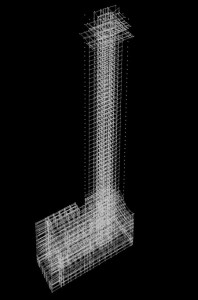Cities positioned in high risk seismic zones continue to grow and demand taller high rise buildings. Current building codes have seismic provisions that impose a building height limit of 160 feet for buildings with traditional structural systems. This height limitation can be avoided by invoking the building code’s alternative provisions clause; which allows the application of an alternative procedure that follows rational analysis and complies with the intent of the provisions in the code. One alternative that is often accepted by building officials is the use of a Performance Based Seismic Design.
Performance Based Seismic Design (PBSD) is a design concept that is currently being applied in seismic design on a variety of buildings and bridges. Its main goal is to produce structures that will have predictable results in the event of an earthquake.
A defining parameter in PBSD is its performance objective: the acceptable level of damage selected for a specified earthquake intensity level. A building may be designed based on one or multiple performance objectives. For example: a residential building could be designed for two performance objectives: 1) to be fully operational (no damage, continuous service) based on an earthquake of low intensity and high probability of occurrence and, 2) to achieve collapse prevention (extensive damage while not endangering the lives of its occupants) for a severe but low probability earthquake event. The selected performance objectives will depend on the intended use of the structure; for example safety-critical buildings, such as hospitals and fire halls, are required to remain operational (light damage, most operations can resume immediately) after a severe earthquake event.
Given that PBSD intends to achieve specific performance objectives, it is necessary for the design to be based on reliable predictions of earthquake shaking and building behavior. Therefore, implementing PBSD requires the following:
- A geotechnical study of the building site that accounts for all nearby seismic faults and local soil conditions which states the likely ground accelerations for each earthquake level determined through a probabilistic analysis.
- State-of-practice modeling techniques of structural components (walls, headers, columns, slabs, etc.) based on findings from analytical and experimental research studies.
- Robust computer software to model the structural system and determine its movement and corresponding forces for each earthquake level.
- PBSD guidelines that provide recommendations on parameters and tolerances for use in design, analysis and evaluation of the structure.
- An independent peer review for quality control that consists of practicing engineers and university professors with reputable experience in seismic engineering.
The importance and inherent value in PBSD is in its refined predictions of earthquake demands and building response. Design engineers can produce more cost-efficient seismic designs by avoiding conservatism found in prescriptive code-based designs. The building owner can potentially use the PBSD data to quantify the repair costs to the building for each earthquake intensity and make informed decisions about their investment.
The application of PBSD in engineering projects has become possible due to the advances in knowledge of earthquake engineering as well as in computing technology. With science and technology continuing to make great progress, it is likely that PBSD and the use of predictable performance objectives will become a more prevalent part in seismic design.
Jose Centeno, Ph.D, Earthquake Engineering Specialist at Glotman•Simpson Consulting Engineers
References:
- Farzad Naeim, Hussain Bhatia, and Roy M. Lobo, “Performance Based Seismic Engineering”, in The Seismic Design Handbook, 2nd, Farzad Naeim (ed.) , 2000
- Moehle, J. P. (2006), “Seismic analysis, design, and review for tall buildings” Struct. Design Tall Spec. Build., 15: 495–513. doi: 10.1002/tal.378
- Mahin, S. “Earthquake resistant design, Section 2 Basic Concepts in Performance-based Earthquake Engineering”, available here (accessed July 7, 2016)

